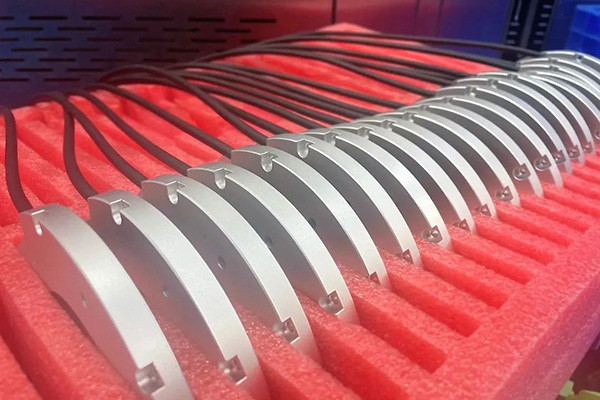Encoders play a critical role in modern industrial systems, offering precision and control in a variety of applications. From high-performance operations to real-time data feedback, encoders have become the backbone of industrial automation, robotics, and even medical devices. In this article, we will explore the intricacies of different types of encoders, their applications in real-time environments, and how to choose the right one for your needs.
Introduction to Encoders
An encoder is a device that converts motion into a measurable electrical signal, providing information about the position, speed, or direction of a mechanical system. This information is vital in industries where precise control and monitoring are required. Encoders are integral in sectors like automotive manufacturing, aerospace, robotics, and more.
How Encoders Work
Encoders detect changes in position by reading specific signals, often through optical, magnetic, or capacitive systems. These signals are then transmitted to controllers, which interpret the data and make necessary adjustments in real time.
High-Performance Encoders
High-performance encoders are designed to meet demanding requirements, especially in environments that require high precision, durability, and reliability. They are built to handle extreme speeds and deliver precise measurements, making them essential in high-stakes applications such as robotics, aerospace, and defense.

Key Features of High-Performance Encoders
- High Resolution: Provides more detailed measurements for precise control.
- Durability: Withstands harsh environments such as extreme temperatures and vibrations.
- High Accuracy: Offers precise feedback for fine-tuned movements.
Types of High-Performance Encoders
Encoders come in various types, each suited for specific environments and tasks:
- Optical Encoders: Use light to detect changes in position. Known for high resolution and accuracy.
- Magnetic Encoders: Ideal for environments with dust or moisture; slightly less accurate than optical encoders but more durable.
- Capacitive Encoders: Utilize changes in capacitance to track position, offering a balance between accuracy and robustness.
Industrial Automation Encoders
In industrial automation, encoders serve as the "eyes" of machines. They provide precise feedback that allows machines to function autonomously, improving productivity and reducing the need for human intervention.
Encoders in Automation
Automation systems use encoders to monitor and adjust movements in real time, whether it's positioning a robotic arm or controlling a conveyor belt’s speed. Encoders ensure that tasks are performed consistently and accurately, contributing to increased operational efficiency.

Importance of Encoders in Industrial Settings
In industrial environments, encoders offer several key advantages:
- Increased Productivity: With precise motion control, machines can operate faster and more efficiently.
- Reduced Downtime: Real-time feedback from encoders helps detect issues before they lead to significant problems.
Cost Savings: By enhancing automation, companies reduce labor costs and improve production speed.
Encoder Applications in Industrial Automation
Encoders are used across a wide range of industries. Some prominent applications include:
- CNC Machines: Encoders provide critical feedback for cutting tools to ensure precision in manufacturing.
- Robotics: They help in controlling the movement of robotic arms, enhancing accuracy and flexibility.
Conveyor Systems: Encoders maintain speed consistency and synchronization in automated conveyor systems.
Encoder R&D: Pioneering Innovation
Research and Development (R&D) play a crucial role in advancing encoder technology. New innovations focus on improving performance, precision, and robustness in challenging environments.
Key Innovations in Encoder R&D
- Miniaturization: Reducing the size of encoders to fit into more compact systems without sacrificing performance.
- Improved Accuracy: Research is focused on increasing the resolution and precision of encoders for industries requiring ultra-high accuracy, such as medical devices and aerospace.
Enhanced Durability: Advances in materials and design are making encoders more resistant to wear, temperature, and environmental factors.
Trends in Encoder R&D
Several trends are shaping the future of encoder technology, including:
- Increased Precision: As industries push for greater accuracy, encoders are being designed to measure minute movements with high accuracy.
Wear Resistance: Development of encoders that can withstand heavy use in rough conditions without degradation in performance.
Real-Time Data with Encoders
One of the key advantages of encoders is their ability to provide real-time feedback. This real-time data is essential for high-speed operations and precision control in industries like robotics and manufacturing.
Benefits of Real-Time Data Encoders
- Immediate Feedback: Adjustments can be made instantly to ensure optimal performance.
Higher Efficiency: Real-time data helps streamline operations, minimizing delays and errors.
Real-Time Data Encoders in Action
Encoders are utilized in several high-tech applications:
- Robotics: Encoders enable robotic arms to perform precise movements by providing real-time positional data.
- Medical Devices: Surgical robots rely on encoders for precision in complex procedures.
Autonomous Vehicles: Encoders assist in navigation, providing real-time feedback on position and speed.
Encoder Selection: Key Considerations
Choosing the right encoder for a specific application can be challenging. Factors to consider include:
- Resolution: How detailed do your measurements need to be?
- Accuracy: What level of precision is required for your system?
- Environmental Conditions: Will the encoder be exposed to dust, moisture, or extreme temperatures?
Durability: How long does the encoder need to last in your specific application?
Selecting Encoders for Specific Applications
Different applications demand different encoder specifications. For example:
- Robotics: Requires high-resolution encoders for fine control over movements.
- Aerospace: Needs encoders that can withstand extreme conditions without sacrificing accuracy.
Manufacturing: Typically looks for encoders that offer a balance between speed, durability, and accuracy.
Precision Encoders: Achieving Ultimate Accuracy
Precision encoders are designed to provide the highest level of accuracy possible, often used in fields where even the smallest deviation can have significant consequences.
Applications for Precision Encoders
- Aerospace Engineering: In navigation systems where millimeter-level precision is critical.
Medical Devices: Where precise positioning ensures successful outcomes in surgeries.
Challenges in Precision Encoding
While precision encoders offer high accuracy, they also face challenges:
- Noise Interference: Electrical or mechanical noise can affect the signal and reduce accuracy.
Environmental Factors: Dust, moisture, and extreme temperatures can degrade performance over time.
Future of Encoders in Industry
The future of encoders is closely tied to advancements in other technologies, such as artificial intelligence (AI) and the Internet of Things (IoT). These developments will further enhance the capabilities of encoders in providing more accurate, real-time data and greater automation across industries.
FAQs on Encoders
Q1: What is an encoder used for?
A: Encoders are used to measure position, speed, and direction in a wide range of industrial applications.
Q2: How do I choose the right encoder for my system?
A: Consider factors such as resolution, accuracy, durability, and environmental conditions when selecting an encoder.
Q3: What are the different types of encoders?
A: The main types are optical, magnetic, and capacitive encoders, each suited for different applications and environments.
Q4: What role do encoders play in industrial automation?
A: Encoders provide critical feedback for controlling machinery, ensuring precise movements and high efficiency.
Q5: Can encoders provide real-time data?
A: Yes, many encoders offer real-time feedback, which is essential for applications like robotics and automated systems.
Q6: What is the future of encoder technology?
A: The future will see encoders becoming more precise, durable, and integrated with AI and IoT technologies.
INQUIRY NOW
